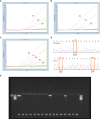Detection of macrolide and fluoroquinolone resistance-associated 23S rRNA and parC mutations in Mycoplasma genitalium by nested real-time PCR
- PMID: 37928183
- PMCID: PMC10623348
- DOI: 10.3389/fcimb.2023.1271392
Detection of macrolide and fluoroquinolone resistance-associated 23S rRNA and parC mutations in Mycoplasma genitalium by nested real-time PCR
Abstract
Background: Traditional drug susceptibility testing cannot be performed in clinical laboratories due to the slow-growing characteristics of Mycoplasma genitalium when cultured in vitro. Sanger sequencing is the standard method for detecting drug resistance-associated mutations. It has been used in some laboratories to guide the choice of macrolide antibiotics for Mycoplasma genitalium infected patients. Furthermore, resistance to fluoroquinolone has become another emerging clinical challenge.
Objective: Sequencing analysis can detect unknown mutations, but it is time-consuming, requires professional analytical skills and the appropriate testing equipment. The main objective of this study was to establish a nested real-time PCR method for the simultaneous detection of 23S rRNA and parC genotypes in relation to the macrolide and fluoroquinolone resistance.
Results: 105 MG-positive samples and 27 samples containing other pathogens were used for validation. The limit of the nested real-time PCR detection was 500 copies/reaction and there was no cross-reaction with Ureaplasma urealyticum, Mycoplasma hominis, Chlamydia trachomatis, Neisseria gonorrhoeae, Human papillomavirus, Herpes simplex virus, Candida albicans and Ureaplasma parvum, but the 23S rRNA assay cross-reacted with Mycoplasma pneumoniae. Compared with sequencing results, the sensitivity of 23S rRNA was 100% (95% CI; 93.3 -100), the specificity was 94.3% (95% CI; 79.4 - 99.0), the overall consistency was 98% (95% CI; 92.5 - 99.7) and kappa value was 0.96 (P < 0.001); the sensitivity of parC was 100% (95% CI; 93.4 - 100), the specificity was 89.7% (95% CI; 71.5 - 97.3) and the overall consistency was 96.9% (95% CI; 90.7 - 99.2) with a kappa value of 0.92 (P < 0.001).
Conclusions: The results of this sensitive and rapid alternative for identifying resistant genotypes of Mycoplasma genitalium are intuitive and easy to interpret, especially for mixed MG populations. Although the relevant 23S rRNA primers need further adjustment, this reliable method would provide an effective diagnostic tool for the selection of antibiotics in clinical practice.
Keywords: 23S rRNA; Mycoplasma genitalium; fluroquinolone; macrolide; nested real-time PCR; parC.
Copyright © 2023 He, Yuan, Liang, Fan, Li and Pan.
Conflict of interest statement
The authors declare that the research was conducted in the absence of any commercial or financial relationships that could be construed as a potential conflict of interest.
Figures

Similar articles
-
Macrolide and fluoroquinolone associated mutations in Mycoplasma genitalium in a retrospective study of male and female patients seeking care at a STI Clinic in Guangzhou, China, 2016-2018.BMC Infect Dis. 2020 Dec 11;20(1):950. doi: 10.1186/s12879-020-05659-3. BMC Infect Dis. 2020. PMID: 33308173 Free PMC article.
-
[Determination of Gene Mutations Associated with Macrolide and Fluoroquinolone Resistance in Patients Infected with Mycoplasma genitalium].Mikrobiyol Bul. 2024 Oct;58(4):353-365. doi: 10.5578/mb.20249624. Mikrobiyol Bul. 2024. PMID: 39745209 Turkish.
-
Multicenter Clinical Evaluation of a Novel Multiplex Real-Time PCR (qPCR) Assay for Detection of Fluoroquinolone Resistance in Mycoplasma genitalium.J Clin Microbiol. 2019 Oct 23;57(11):e00886-19. doi: 10.1128/JCM.00886-19. Print 2019 Nov. J Clin Microbiol. 2019. PMID: 31434719 Free PMC article.
-
Prevalence of mutations associated with resistance to macrolides and fluoroquinolones in Mycoplasma genitalium: a systematic review and meta-analysis.Lancet Infect Dis. 2020 Nov;20(11):1302-1314. doi: 10.1016/S1473-3099(20)30154-7. Epub 2020 Jul 2. Lancet Infect Dis. 2020. PMID: 32622378
-
Global analysis on the mutations associated with multidrug-resistant urogenital mycoplasmas and ureaplasmas infection: a systematic review and meta-analysis.Ann Clin Microbiol Antimicrob. 2023 Aug 10;22(1):70. doi: 10.1186/s12941-023-00627-6. Ann Clin Microbiol Antimicrob. 2023. PMID: 37563660 Free PMC article.
Cited by
-
The correlation between positive rate of antibody or DNA and children's age with suspected Mycoplasma pneumoniae infection.Ital J Pediatr. 2025 May 28;51(1):156. doi: 10.1186/s13052-025-01993-x. Ital J Pediatr. 2025. PMID: 40437533 Free PMC article.
-
Chinese advances in understanding and managing genitourinary tract infections caused by Mycoplasma genitalium, Mycoplasma hominis, and Ureaplasma urealyticum.Arch Microbiol. 2024 Nov 28;207(1):5. doi: 10.1007/s00203-024-04204-z. Arch Microbiol. 2024. PMID: 39607610 Review.
References
-
- Bissessor M., Tabrizi S. N., Twin J., Abdo H., Fairley C. K., Chen M. Y., et al. . (2015). Macrolide resistance and azithromycin failure in a Mycoplasma genitalium-infected cohort and response of azithromycin failures to alternative antibiotic regimens. Clin. Infect. Dis. 60 (8), 1228–1236. doi: 10.1093/cid/ciu1162 - DOI - PubMed
-
- De Baetselier I., Kenyon C., Vanden Berghe W., Smet H., Wouters K., Van den Bossche D., et al. . (2021). An alarming high prevalence of resistance-associated mutations to macrolides and fluoroquinolones in Mycoplasma genitalium in Belgium: results from samples collected between 2015 and 2018. Sex Transm. Infect. 97 (4), 297–303. doi: 10.1136/sextrans-2020-054511 - DOI - PubMed
-
- De Baetselier I., Vuylsteke B., Reyniers T., Smet H., Van den Bossche D., Kenyon C., et al. . (2022). Worryingly high prevalence of resistance-associated mutations to macrolides and fluoroquinolones in Mycoplasma genitalium among men who have sex with men with recurrent sexually transmitted infections. Int. J. STD. AIDS. 33 (4), 385–390. doi: 10.1177/09564624211070704 - DOI - PubMed
MeSH terms
Substances
LinkOut - more resources
Full Text Sources

